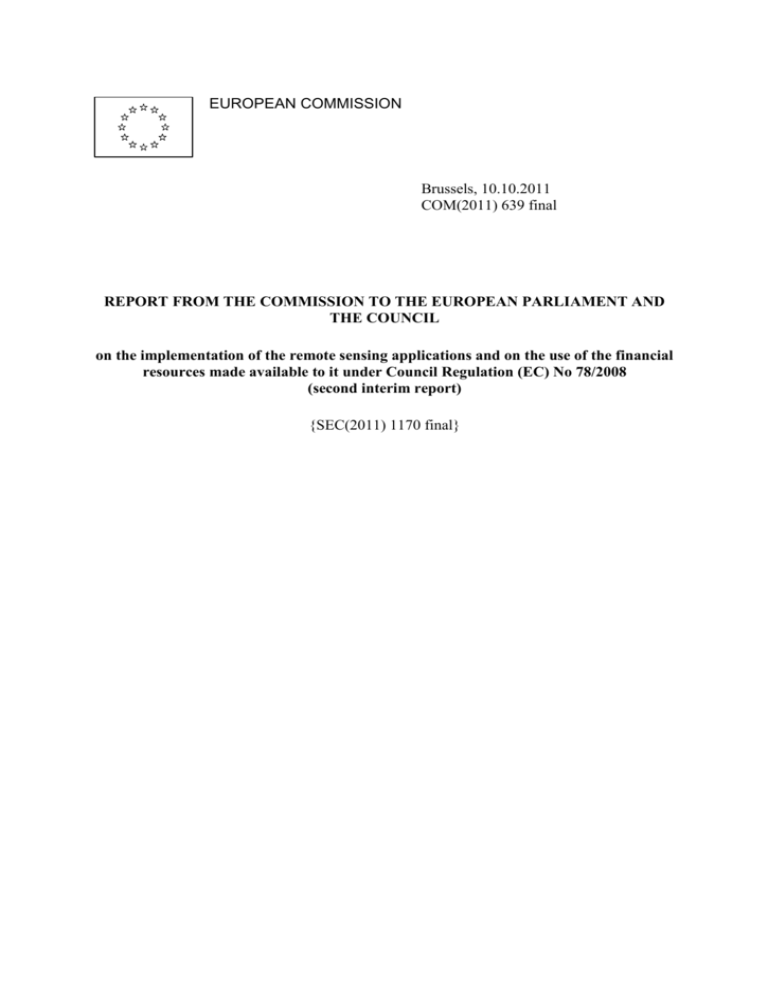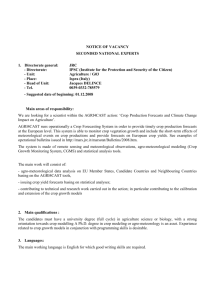2. The MARS Crop Yield Forecasting System
advertisement

EUROPEAN COMMISSION
Brussels, 10.10.2011
COM(2011) 639 final
REPORT FROM THE COMMISSION TO THE EUROPEAN PARLIAMENT AND
THE COUNCIL
on the implementation of the remote sensing applications and on the use of the financial
resources made available to it under Council Regulation (EC) No 78/2008
(second interim report)
{SEC(2011) 1170 final}
REPORT FROM THE COMMISSION TO THE EUROPEAN PARLIAMENT AND
THE COUNCIL
on the implementation of the remote sensing applications and on the use of the financial
resources made available to it under Council Regulation (EC) No 78/2008
(second interim report)
1.
INTRODUCTION
Detailed information on the use of agricultural land and the conditions of arable
crops is essential to the quality of yield and agricultural production forecasts. Such
information is of particular use for market monitoring and the management of related
market measures under the single Common Market Organisation. In this context, the
European Union has made substantial efforts to develop and improve innovative
technologies and models specifically related to remote-sensing applications. The
experience accumulated has shown that remote-sensing provides independent
information of high quality which cannot be obtained from traditional agricultural
statistics and forecasting systems.
Council Regulation (EC) No 78/2008 1 provides the legal framework for these
remote-sensing activities for the period 2008-2013.
The remote-sensing applications supported under this framework provide useful
information to the European Commission, to interested Member States, to research
institutes and to other users, through the dissemination of different products. Since its
creation, the system has been continuously improved. Additionally to the primary
objective of producing yield and harvest forecasts, the system also provides useful
insights into other fields relevant to EU agriculture such as climate change.
Article 4 of Regulation (EC) No 78/2008 provides that the Commission shall submit
a final report no later than 31 July 2013 on the implementation of the remote-sensing
measures and on the use of the financial resources made available to it under the
Regulation. This second interim report is drawn up in view of a continuation of these
measures within the framework of the CAP beyond 31 December 2013.
The report elaborates on a possible scenario for continuation of the existing MARS
Crop Yield Forecasting System for the EU and of an extension to a wider global
coverage with the objectives of further improving yield forecasts for the EU and of
contributing to the international initiatives launched by G20 agricultural ministers.
1
EN
Council Regulation (EC) No 78/2008 of 21 January 2008 on the measures to be undertaken by the
Commission in 2008-2013 making use of the remote-sensing applications developed within the
framework of the common agricultural policy, Official Journal of the European Union, L 25 of
30 January 2008, p. 1.
2
EN
2.
THE MARS CROP YIELD FORECASTING SYSTEM
The Mars Crop Yield Forecasting System (MCYFS) started in 1988 as a 10-year
pilot project to produce crop yield and harvest forecasts. The activity, which was
then called Monitoring Agriculture with Remote Sensing (abbreviated MARS),
concentrated on the assessment of crop yields and production volumes of various
crops within the EU, on the basis of meteorological analysis, agro-meteorological
simulated crop growth indicators, low-resolution satellite data and statistical analysis.
From 1999 onwards this activity was carried out under the legal basis of Decision
1445/2000/EC2 for the period 1999-2003 and its extension for the period 2004-2007
with Decision 2066/2003/EC3. Since 2008 and until 2013, the activity is
implemented under Council Regulation (EC) No 78/2008. The MCYFS is operated
within the AGRI4CAST Action in the Institute for Environment and Sustainability
(IES) of the Joint Research Centre (JRC).
The MCYFS is a complex, integrated analysis tool addressing the objectives set in
the Regulation, more specifically the monitoring of crop conditions, yields and
agricultural production.
The system consists of several independent modules, which are integrated to monitor
crop behaviour and to produce crop yield forecasts. From a technical point of view,
the MCYFS includes: 1) the maintenance of a meteorological database (see Article
1(2)(a) of the Regulation); 2) the application of agro-meteorological models (see
Article 1(2)(d)); 3) the processing of low resolution satellite data (see Article
1(2)(a)); 4) statistical analyses and yield forecasts of the main crops at national level
across the EU (see Article 1(2)(b)) as well as visualization tools. The MCYFS is run
operationally covering the whole European Continent, the Maghreb countries and
Turkey. The crops covered by the simulation models are soft wheat, durum wheat,
winter and spring barley, grain maize, rapeseed, sunflower, potato, sugar beet,
pasture, rice, and other cereals.
More detailed information concerning the system and its outputs can be found in the
accompanying Commission Staff Working Document.
(1) Meteorological database
Meteorological data are collected from meteorological stations throughout Europe,
then quality checked and further processed, and finally analysed. As such this
meteorological database can be used to trigger risk warnings (e.g. detection of
abnormal weather conditions during a given month). Furthermore weather forecast
data from the European Centre for Medium-Range Weather Forecasts are analysed to
prepare outlooks on weather conditions affecting agricultural land.
2
3
EN
Decision 1445/2000/EC of the European Parliament and of the Council of 22 May 2000 on the
application of aerial-survey and remote-sensing techniques to the agricultural statistics for 1999 to
2003, Official Journal of the European Communities L 163 of 4 July 2000, p. 1.
Decision 2066/2003/EC of the European Parliament and of the Council of 10 November 2003 on the
continued application of areal-survey and remote-sensing techniques to the agricultural statistics for
2004 to 2007 and amending Decision 1445/2000/EC, Official Journal of the European Union L 309 of
26 November 2003, p. 9.
3
EN
(2) Agro-meteorological models used for crop growth simulation
Agro-meteorological models are run to convert the meteorological data into
estimations on crop biomass production. The tools used are the Crop Growth
Monitoring System (the World Food Study model - WOFOST - adapted to the
European scale), the pasture model LINGRA and the rice model WARM (Water
Accounting Rice Model).
Additional information, such as soil parameters, crop calendars, crop practices and
crop parameters, is utilised to produce the simulations. At this level, many crop
specific indicators/predictors (e.g. potential biomass) are produced and transferred to
the statistical analysis for the production of quantitative yield forecasts. These
elements also contribute to the assessment of crop conditions (Article 1(1)(b) of the
Regulation). Outputs include maps indicating extreme temperature at a given crop
stage, simulations of biomass and grain production, estimations of actual soil
moisture reserve, the crop development stage in a given month, and the divergence
from the long-term average at a given decade or period within the growing season for
any agro-meteorological indicator.
(3) Low resolution satellite data
Remote-sensing applications feed into the system at all the levels and contribute to
improve the agricultural forecasting models as well as to establish regionally-based
models. Information from meteorological satellites is used in addition to the data
delivered by meteorological stations (e.g. radiation measured by satellites at the
resolution level of 5 km). The remote-sensing information is processed to produce
“measured” vegetation indicators, which can be compared with the agrometeorological indicators and used for the statistical analysis. Low to medium
resolution satellite sensors are utilised: SPOT Vegetation/NOAA-AVHRR (about 1
km resolution) and MODIS (about 300-500 m resolution)4.
(4) Statistical analysis
The indicators obtained from the meteorological database, the agro-meteorological
database and the remote sensing database are compared to the yield time series and
analysed with statistical methods (e.g. regression or scenario analysis). The final
results are quantitative yield forecasts which, together with the analysis of the
abovementioned outputs, are published in the MARS bulletins. Data available in the
system cover a long period of time, starting in 1975.
(5) Visualization tools and dissemination of outputs
The databases (meteorological information, agro-meteorological information,
remote-sensing information) can be explored by users via information tools.
AGRI4CAST maintains a web portal where remote-sensing data can be screened and
downloaded and a portal where the meteorological and agro-meteorological
information can be viewed and downloaded in the form of electronic maps. It is also
4
EN
The abbreviation SPOT stands for "Satellite Pour l'Observation de la Terre", NOAA stands for National
Oceanic and Atmospheric Administration and AVHRR for Advanced very high Resolution Radiometer,
MODIS stands for Moderate Resolution Imaging Spectroradiometer.
4
EN
possible to download the analysis on crop conditions and yield estimates. All
elements listed above are utilised for the preparation of bulletins and specific studies
on climatic conditions (see Article 1(2)(c)). They provide the analyses of the crop
situation in different regions of the EU, maps of weather and crop indicators and
yield expectations. The MARS Bulletin is published regularly during the main
growing season on paper and on the internet.
3.
IMPLEMENTATION
3.1.
Overall implementation
For the continuation of the operational services from 2008 until 2013 according to
Council Regulation (EC) No 78/2008, a new project, called MARSOP3, has been
launched. It focuses on the provision of operational near-real time products to the
JRC for the monitoring of agricultural production and yield in Europe. In August
2007 a call for tender (Operational activities for MARS actions -MARSOP3- 20082013, Contract Notice N° 2007/S 154-191094) was published in the supplement of
the Official Journal of the European Union. After the evaluation of the offer for Lot I
(meteorological data) and Lot II (acquisition and processing of satellite data) and the
favourable opinion of the Public Procurement Advisory Group, a contract was signed
with a consortium led by Alterra BV. On the basis of the operational products
delivered within this contract, the JRC analyses crop conditions and prepares yield
and production estimates. This information is made available to the European
Commission, Member States and EU citizens.
3.2.
Implementation with regard to Article 1 of Council Regulation (EC) No 78/2008
Article 1 of Council Regulation (EC) No 78/2008 sets the objectives for the
implementation of remote-sensing measures (Article 1(1)) and provides details on
the measures to be undertaken (Article 1(2)). For ease of reference, the description of
the implementation of the measures follows the structure of Article 1.
3.2.1.
Aims of the implemented measures (Article 1(1))
Article 1(1)(a): management of agricultural markets
The activity delivers independent, timely, scientific and traceable crop yield forecasts
for all Member States and EU neighbouring countries for selected arable crops. This
information is utilised by the Commission services for the following main purposes:
1) update of crop supply balance sheets; 2) assessment of climatic conditions and
potential impacts of particular weather events in the Member States or regions (e.g.
impact of a late frost event); 3) monitoring of crop conditions in third countries.
AGRI4CAST yield forecasts are also provided to the Early Estimate System of
Eurostat. Independence and reliability of the outputs prepared by AGRI4CAST are
viewed as important assets by the Commission services. The statistical analysis
performed with the crop growth indicators is transparent, traceable and stored for all
crop simulations and years. A set of statistical indicators (e.g. root mean square error
for different confidence intervals, standard deviation) is provided for each of the
models. At the end of the forecasting campaign, an error analysis compares the crop
EN
5
EN
yield forecasts with the actual observed yields to quantify the forecast error and to
evaluate the forecasting performance.
For information, the overall error, measured as the mean absolute percentage error of
the end-of-campaign forecast for the EU-27 across all months and for all cereals
together, has been 1.6 % for 2007, -3.3 % for 2008, -1.2 % for 2009, and 1.2 % for
2010, respectively, with negative values indicating an underestimation, positive
values an overestimation of reported yields (reported yields of 2009 and 2010 are
still preliminary).
Article 1(1)(b): monitoring of crop conditions and estimates
Besides yield forecasts, crop conditions are closely monitored throughout the
growing season. Meteorological and remote-sensing information is analysed and
linked to relevant crop information based on the results of biophysical modelling
(e.g. impact of a heat wave, a dry spell, or a cold shock at certain crop development
stages). Furthermore, outputs of the crop growth model are directly used to assess
crop conditions (e.g. simulated leaf area index or simulated biomass). This
monitoring covers the EU and applies to all the included crops.
Article 1(1)(c): promotion of access to the estimates
An open access to the various outputs is guaranteed by the websites maintained by
the JRC and by the MARSOP3 consortium. The MARSOP website offers a wide
range of information (results from the applied remote-sensing measures, crop growth
model outputs, links to the bulletins). Satellite data and images are organised into an
image server where the data can be viewed and downloaded. It is also possible to
request and download meteorological data from the MARSOP website.
Article 1(1)(d): ensuring the technological follow-up of the agro-meteorological
system
The JRC performs a constant technical follow up to ensure the continuity of the
system and to guarantee the scientific robustness of the methodologies applied.
These methodologies include the interpolation of the meteorological data onto a
raster, the derivation of remote sensing measures to describe the growing behaviour
of crops or the statistical analysis performed to obtain the crop yield estimates.
3.2.2.
Measures to be implemented (Article 1(2))
Article 1(2)(a): collection and purchase of meteorological and satellite data
The collection and purchase of meteorological data comprises more than 3500
stations delivering information on weather parameters, which are fed into the
MCYFS on a daily basis. This service is permanently maintained. Freely available
remote sensing data from low and medium resolution satellites (1 km to 300 m pixel
resolution) devoted to vegetation monitoring are also acquired, stored, further
processed and analysed.
EN
6
EN
Article 1(2)(b): spatial data infrastructure and website
Spatial data infrastructure comprises the technology, standards, human resources and
related activities necessary to acquire, process, distribute, use, maintain and store
spatial data. This infrastructure has been put in place with the MCYFS, involving
teams at the JRC and under the MARSOP3 contract. It covers spatial data sets for the
whole of Europe at different scales. The data are processed to account the needs of
crop condition monitoring and forecasting of crop production. The outputs and
information resulting from the different sources (e.g. remote-sensing) are available
via different websites and web portals.
The infrastructure complies with the framework set by the Infrastructure for Spatial
Information in the European Community (INSPIRE) Directive5: The spatial data are
geo-referenced according to the INSPIRE projection, the metadata description
follows the INSPIRE principles and will be further harmonized.
Article 1(2)(c): specific studies on climatic conditions
The system allows the preparation of specific studies on the climatic conditions
thanks to the large array of information available covering all relevant aspects. The
following specific studies were prepared since Council Regulation (EC) No 78/2008
entered into force:
5
EN
Analysis of the impact of the spring-summer drought and the abundant rain in
August 2008 on winter cereals production in Latvia
Analysis of the impact on agriculture of extreme weather conditions during
several days of July and August 2008 in Slovenia
Water availability for rice growing in Spain in 2008 (analysis of cumulated
rainfall)
Analysis of the impact of 2009 winter frost events on winter cereals in Europe
Analysis of the weather conditions during the spring/summer 2010 and their
possible impact on agricultural production in Belgium
Analysis of the weather conditions during the autumn and winter of 2009/10
and their possible impact on agricultural production in Spain
Analysis of the weather conditions during the spring and summer 2010 and
their possible impact on agricultural production in Hungary
Analysis of the autumn and winter 2009/10 weather conditions and their
possible impact on agricultural production in Italy
Directive 2007/2/EC of the European Parliament and of the Council of 14 March 2007 establishing an
Infrastructure for Spatial Information in the European Community (INSPIRE), Official Journal of the
European Union L 108 of 25 April 2007, p. 1.
7
EN
Analysis of the weather conditions during the winter and spring in 2010 and
their possible effect on agricultural production in Lithuania
Analysis of the 2010 rainfall conditions and their possible impact on
agricultural production in Romania
Analysis of the weather conditions during the 2009/2010 crop season and their
possible impact on agriculture in Luxemburg
Article 1(2)(d): updating of agro-meteorological and economic models
Besides the operational running of the system, models and related databases are
updated continuously. The database contains currently three terra bytes of
information. Since the Council Regulation entered into force, major improvements
have taken place: The meteorological station network has been densified to ensure a
better monitoring system; the resolution of the former 50 km x 50 km grid for the
spatial analysis has been improved to 25 km x 25 km; new crop calibrations have
been performed; and a new database and software version has been released.
4.
DELIVERABLES AND OUTPUTS
The European Commission, Member States and other interested stakeholders receive
the different deliverables; reports and bulletins on the one hand and information
services and data on the other hand. All products are available electronically (Article
2 of the Regulation) and partially on paper format.
Reports and Bulletins
The crop monitoring bulletin for Europe offers, in near real time and operational
context, information and analyses on crop growth monitoring and yield forecasting.
Countries covered are those of the EU and neighbouring regions (Maghreb, Black
Sea area). The crops covered are soft wheat, durum wheat, winter barley, spring
barley, grain maize, rapeseeds, sunflower, sugar beet and potato. A full analysis is
published on the internet six times per year and supplemented by updated yield
estimates two or three times per year. Special bulletins are prepared for pastures and
rice in the EU. Updates and reviews of agro-meteorological conditions are provided
between the full analysis bulletins (10-12 times per year). All these publications are
available in the internet or in paper format upon request.
Information services and data
A large variety of information about the current agricultural production season in
Europe and other important agricultural areas in the world is offered on the
MARSOP web viewer and pages. Available products include graphs and maps of
weather indicators based on observations and numerical weather models, graphs and
maps of crop indicators based on agro-meteorological models and graphs and maps
of vegetation indices and cumulated dry matter based on remote sensing images.
EN
8
EN
5.
BUDGET RESOURCE USE
Table 1. Use of financial resources under Council Regulation
(payment credits, in €; * = committed, ** = paid until moment of writing)
2008
Amount
2009
Short description
(EC)
No
78/2008
in
2008,
2010
Amount
Short description
LOT 1 / phase 1
1 016 084
Interim and final
payment
LOT 1 / phase 2
283 185
Interim payment
LOT I / phase 3
67 800
Near real time
stations (more than
250)
LOT 2 / phase 1
387 720
Interim and final
payment
Lot 2 / phase 2
137 989
Interim payment
Lot 2 / phase 3
Amount
Short description
424 777
Final payment
288 707
Interim payment
0
NRT and archive
stations
206 984
Final payment
135 143
Interim payment
Lot 2 / first
renewal phase 3
MARS Database
and
information
technology
(IT)
support
97 298
TOTAL
97 298
EN
MARS DB
information
systems
maintenance
development
and
477 562
and
MARS DB
information
systems
maintenance
development
2 370 340
and
359 239
and
1 414 851
9
2010,
and
2011
2011
(preliminary)
LOT
1/
first
renewal phase 3
Additional
meteorological
stations for LOT 1
2009,
MARS DB
information
systems
maintenance
development
and
Amount
Short description
433 061
Final payment
302 544*
Interim payment
21 600**
Archive stations
202 715
Final payment
141 620*
Interim payment
333 196*
MARS DB
information
systems
maintenance
development
and
and
and
1 443 608*
EN
Lot 1 covers the procurement of meteorological and weather forecast data (including the
densifying of network of meteorological stations). It covers the operational run and
maintenance of the crop growth models operated within the MCYFS. Results in the form
of database updates and maps are delivered to the database at the JRC daily or every ten
days. Appropriate tools for exploitation of the results are maintained and developed.
Maintenance and improvement of MARSOP website is also part of this lot together with
overall coordination and management.
Lot 2 covers the processing of remote-sensing data. The work performed covers all data
enhancement steps between the acquisition of the raw imagery and the delivery of 10-daily
composites (data ingestion, calibration, etc.).
Mars database and IT support: the MCYFS calls for the provision of IT services to
ensure a timely production of bulletins. Work performed covers the management and
maintenance of the database with all the remote sensing data, the meteorological data and
the agro-meteorological indicators. Development and maintenance of analysis tools and
websites are part of this component.
6.
CONCLUSIVE REMARKS AND FUTURE OF THE ACTIVITY
The MARS System has provided effective and timely information and objective data in
support to the decision making process for the deployment of the Common Agricultural
Policy (CAP). Beyond the primary objective of producing harvest yield and production
forecasts, the system also provides useful insights into other fields relevant to EU
agriculture such as climate change issues. Moreover, the MARS agro-meteorological
system and remote-sensing applications have provided useful information not only to the
European Commission but also to interested Member States, research institutes and other
users, through the dissemination of products.
The possible continuation of the MARS Crop Yield Forecasting System could include new
activities to follow the needs of the CAP, which evolves and adapts to a changing global
economic environment. In this context, independent and reliable information at world level
is a basic requirement to ensure the correct and effective decision-making process within
the EU. The new activities would include:
(1)
A MCYFS enlarged to other main production areas of the world and to additional
relevant crops;
(2)
A modelling tool extended to EU crops other than those currently covered (e.g. to
rye, oats, triticale);
(3)
A more complete modelling of pasture systems able to provide quantitative estimates
of biomass production.
As regard point 1, in 2011 DG AGRI launched a project called GLOBCAST (GLOBal
Crop Monitoring and ForeCASTing) through an Administrative Arrangement with the JRC
that will end in 2013. The aim of the GLOBCAST project is to study the enlargement of
the MCYFS to other areas of the world (Russia and CIS countries, Argentina, Brazil,
China, India, Australia, Canada and the USA) and to other crops of interest, like soybean
EN
10
EN
and sugar cane. In the first year the JRC will re-visit the existing data and will adapt the
software and modelling tools to organise and implement the future pre-operational system
in the years 2012 and 2013. According to the assessment of the GLOBCAST project, the
resulting activities could be thereafter included in the MARS programme for yield
forecasts.
The GLOBCAST project aims to provide a major contribution of the EU to the recent G20 initiative on food security and price volatility, in particular to the Agriculture Market
Information System (AMIS), included in the "Action Plan on Food Price Volatility and
Agriculture"6 adopted by the G-20 Agriculture Ministers. An extended MARS Crop Yield
Forecasting System will contribute to AMIS via the Group on Earth Observation (GEO),
which has as an objective to reinforce the capacity to produce and disseminate timely and
accurate crop production forecasts on a national, regional and global scale. The EC is
committed to participate in those initiatives with data and information on markets, stocks
and productions. Deliverables of the existing MCYFS implemented under Council
Regulation (EC) No 78/2008 and results of the GLOBCAST project are already and could
continue to be contributions to the AMIS system.
There are close links between the MARS Crop Yield Forecasting System and the Global
Monitoring for Environment and Security (GMES) Programme activities. The possibilities
for enhancing synergies between GMES and MARS Crop Yield Forecasting System
activities are under discussion, in particular regarding the procurement and pre-processing
of satellite data which could benefit from the GMES data and information.
6
EN
http://agriculture.gouv.fr/IMG/pdf/2011-06-23_-_Action_Plan_-_VFinale.pdf
11
EN






